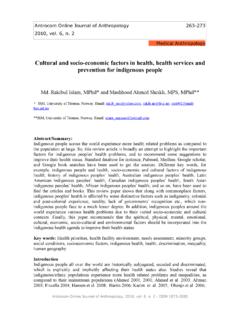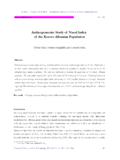Transcription of Community Participation in Disaster Management: Role of ...
1 A. Hossain Community Participation in Disaster ManagementSociology159 - 171 Community Participation in Disaster Management: Role of Social Work to Enhance ParticipationMd. Anwar Hossain*AbstractBangladesh is one of the most vulnerable areas to natural disasters in the world. Almost every year different types of natural disasters occur in Bangladesh and destroy many lives and resources of people. Although it is not possible to prevent the occurrence of disasters influenced by natural causes, proper plan, management and human collective Participation may minimize the natural disasters occurred. Bangladesh is no exception in this regard. However, the government of Bangladesh has adopted Disaster management plans and programs with especial emphasis on Community Participation in Disaster management cycle since her independence. Based on literature review this paper analyzes the approaches to Disaster management and its institutional framework in Bangladesh, and also discusses the role of social work to ensure or enhance Community Participation in Disaster management that may contribute to both anthropology and social work disciplines.
2 1. IntroductionBangladesh is crisscrossed by a strong river network of three major rivers the Padma, the Brahmaputra, and the Meghna and their tributaries, numbering about 230. Climatically it is situated in humid tropical zone. Although the country is a beauty of nature with cultural heritage, it is highly vulnerable to natural hazards such as flood, cyclone, drought, tidal surge, cold wave, earthquake, river-bank erosion, arsenic contamination of ground water, water and soil salinity and various forms of pollution due to her geographical location, land characteristics, multiplicity of rivers and monsoon climate ( Disaster management Bureau, 2008, p. 3). Since the independence in 1971, the country has experienced 200 natural disasters causing loss of more than 600,000 lives, millions of livestock and leaving prolonged damage to property, quality of life and livelihoods (Ministry of Foreign Affairs, 2006, p. 7). Hence, Disaster event should be faced with proper plan and programs through which active Participation of affected people has to be ensured in an attempt to reduce the damages of property, and to shorten the pains and sufferings of people as well as enhance the sustainable development process.
3 In so doing, the government of Bangladesh adopted Draft National Disaster management Policy (NDMP) in 2008 and prepared the National Plan for Disaster management (NPDM) 2010-2015 in 2010, emphasizing on capacity building as well as on promoting livelihood of the Disaster -prone Community in accordance with philosophy of alternative perspective of Disaster management . It is considered as a bottom-up approach. This paper discusses the concepts and approaches to Disaster management , policies, institutional arrangement, Disaster management practices and role of social work to make Disaster management fruitful with special reference to Bangladesh. 2. Objectives and MethodologyThe main objective of this paper is to analyze the policies and practices of Disaster management in Bangladesh. It also highlights reasons behind adopting bottom-up approach and Community -based Disaster management *Associate Professor, Department of Social Work, Jagannath University, Dhaka-1100, Bangladesh.
4 Email: ahossainsw@ Online Journal of Anthropology 2013, vol. 9. n. 1 ISSN 1973 2880 159 A. Hossain Community Participation in Disaster management (CBDM) practices in rural Bangladesh, and locates the limitations of Community Participation . The paper also sheds light on role of social work to enhance Community Participation to make Disaster management a success. This paper is qualitative in nature and document analysis method has been used as a research approach. Data have been collected from secondary sources such as government document, research reports as well as journal and newspaper articles to analyze the research Conceptual FrameworkDisaster and Disaster ManagementDisaster management is concerned with preparing for, ameliorating of the impact and reducing the risk of disasters occurred. It involves both the emergency operation in a Disaster as well as the rebuilding the society in aftermath of Disaster (Tan, 2009).
5 It is connected with multifarious factors. Over a decade there has been a profound discussion of social and economic issues related to Disaster . During this period some important concepts and terms have been introduced to the field or issue that leads to what is commonly understood as Disaster . Therefore, it is necessary to have clear idea about Disaster before going to explain the concept of Disaster management . Disaster is, generally, described as combination of hazard and vulnerability. Ariyabandu (2003, p. 28) explains these concepts distinctly in the following way: hazard is defined as the probability of the occurrence of a dangerous phenomenon at a given place within a given period of time.. On the other hand, vulnerability is defined as the degree of susceptibility to a hazard, or the lack of capacity to absorb the impact of a hazard and recover from it. Vulnerability also refers to a set of prevailing and consequential conditions which adversely affect the ability of a person, group or Community to prevent, mitigate, prepare for and respond to hazardous events and recover from impact of natural hazards (Bhatti, 2003, p.)
6 58; O Brien, et al., 2006, p. 70). It is related not only to physical factors, but also to a range of social, economic, cultural and political factors (Ariyabandu, 2003, p. 28). Some contemporary studies suggest that hazards might have their origin in nature but these turn into disasters through societal process. For example, climatic hazards like flood, cyclone, drought, tidal wave etc. are meteorological risk but these turn into disasters when the structural and non-structural infrastructures of affected area are too shabby to cope with these risks (Bhatti, 2003, p. 58). Therefore, a Disaster is an outcome of a hazard impacting on vulnerable populations. In this situation hazard by itself is not a Disaster unless there are vulnerable populations who do not have the capability to combat it and who are unable to cope with it. UNDP (2007, p. 2) analyzes this issue more substantially. It defines Disaster as a function of the risk process. It results from the combination of hazards, conditions of vulnerability and insufficient capacity or measures to reduce the potential negative consequences of risk.
7 Natural hazards become disasters if they induce a serious disruption of the functioning of a Community or a society causing widespread human, material, economic or environmental losses, which exceed the ability of the affected Community or society to cope using its own resources. Therefore, managing Disaster entails managing vulnerabilities that include five basic phases: prevention, preparedness, emergency response, recovery and mitigation (Bhatti, 2003, p. 59). Prevention includes the measures taken to impede the occurrence of a Disaster . But it is not possible to prevent the occurrence of natural disasters fully, though the extent of its damages can be reduced (Ahmed, 1994, p. 33). Preparedness covers the activities designed in anticipation of a Disaster to ensure that appropriate and effective action is taken earlier. These actions include the Disaster plans, the training of responders, the maintenance of human, material and financial resources and the establishment of public education and information system (Kreps, et al.)
8 , 2006, p. 19). Emergency response covers the indispensable services and activities that are undertaken during the initial impact or in the aftermath of a Disaster including those to save lives and to prevent further damage to property (Bhatti, 2003; Kreps, et al., 2006; Kapucu, 2008). Recovery is the action or process of getting back something that has been lost (Hornby, 2000, p. 1063). Recovery, in Disaster management , refers to the activities that are taken after the initial impact to develop socio-economic and environmental conditions that are destroyed by Disaster aimed at achieving return to normality (Kapucu, 2008, p. 244), that is, Disaster recovery activities are related to the reestablishment of pre- Disaster social and economic routine provision of financial and other services to the victims, as well as repair of destroyed properties (Kreps, et al., 2006, p. 20). Mitigation involves the measures that can be adopted to minimize the destructive effects of hazards and to lessen the magnitude of Disaster .
9 These activities can occur before, during and aftermath of Disaster and overlap of all phases of Disaster management (Fernando, 2001, p. 2). In this paper, therefore, flood, cyclone, drought, tidal surge, tornado, cold wave, river Antrocom Online Journal of Anthropology 2013, vol. 9. n. 1 ISSN 1973 2880 160 A. Hossain Community Participation in Disaster Managementerosion, arsenic contamination of ground water are considered as Disaster when it turns into hazardous event and affects a given place and the vulnerable people of that area who are not able to cope with it. On the other hand, Disaster management is considered as an approach combination of prevention, preparedness, mitigation, emergency response and recovery to cope with hazardous situation created by above-mentioned natural ParticipationCommunity Participation , generally, refers to the involvement of people in any project to solve their own problems or to develop their socio-economic conditions.
10 They participate in setting goals, and preparing, implementing and evaluating plans and programs. The United Nations (1970) defines Participation as the collective action by the various strata of people or interest groups. Basically, it is a dynamic group process in which all members of a group contribute, share or are influenced by the interchange of ideas and activities toward problem-solving or decision-making (Banki, 1981, p. 533 cited in Samad, 2002, p. 53). The crux of Community Participation is the exercise of voices and choices of the Community and the development of human, organizational and management capacity to solve problems as they arise in order to sustain the improvements made over the time (Sastry, 2001, p. 2). Community Participation motivates people to work together where people feel a sense of Community and recognize the benefits of their involvement. In this paper Community Participation is used as the process of people s involvement in setting goals, and preparing, implementing and evaluating plans and programs in every phases of Disaster management program where voices and choices of the Community are addressed adequately.

